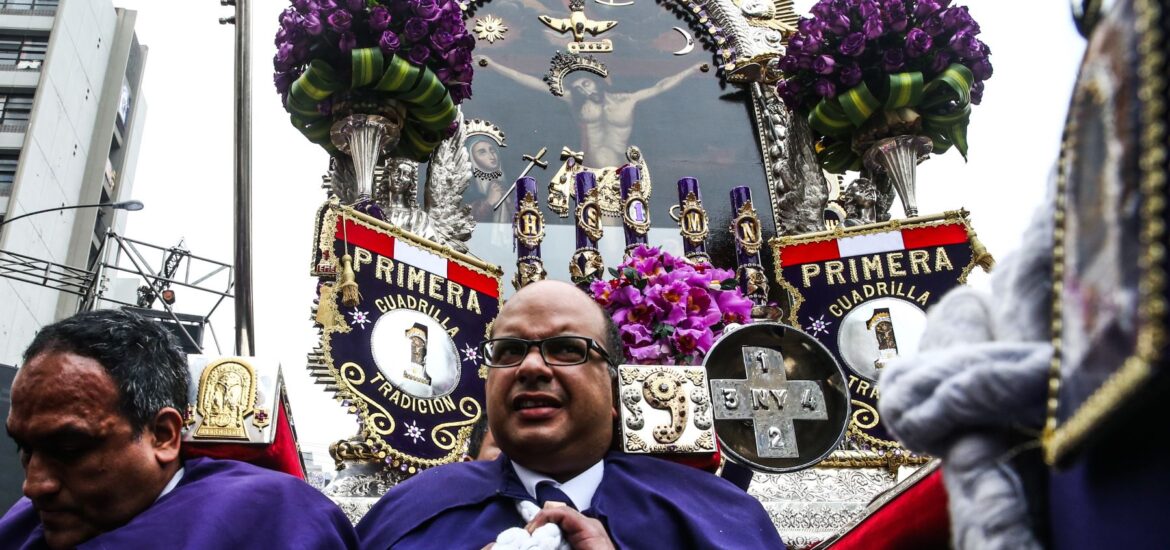In October, the streets of Peru’s capital, Lima, transform into a sea of purple for the grand celebration of “El Señor de los Milagros” (The Lord of the Miracles). This religious feast brings together faith, tradition, and history, creating one of the most significant events in Peru.
In this guide, we’ll explore the origins of this festival and why the image of the dark-skinned Christ continues to attract thousands of followers each year. Whether you’re a believer or simply curious, we’ll also highlight the main activities to experience during this vibrant celebration.
Origin of the Lord of the Miracles
The story of the dark-skinned Christ is a mix of history and legends. One story says that on November 13, 1655, a significant earthquake hit Lima, causing great damage to the Pachacamilla area. However, one remarkable structure survived the quake: an adobe wall with a mural of a crucified Christ, surrounded by a sun and a moon.
The creator of this mural was unknown, although some historians mention that it might have been painted by an Angolan slave around 1651. As time passed, the local community began to see the painting as special, believing it had miraculous powers and was protected by divine care.
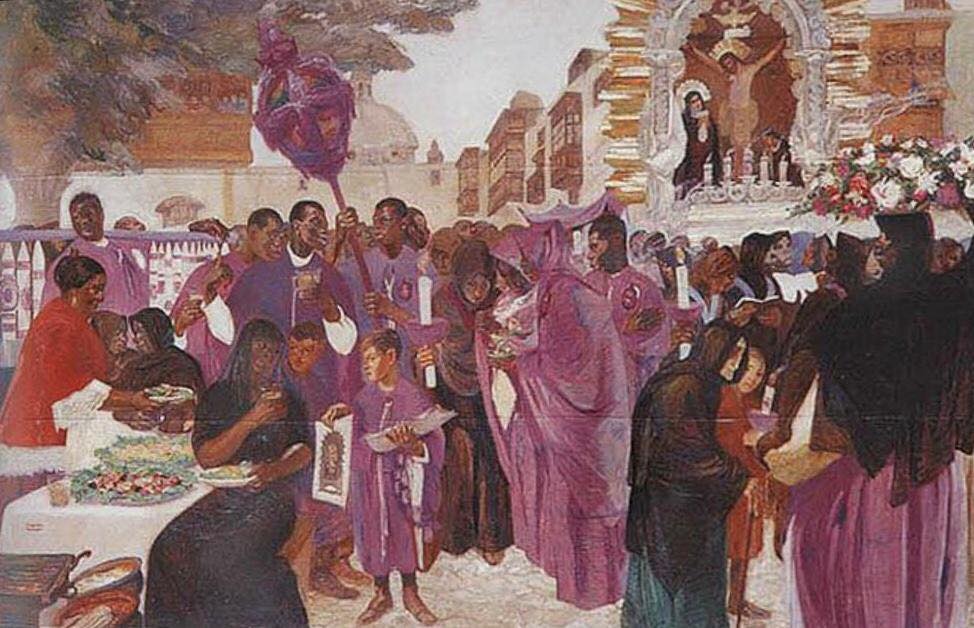
When the mural’s miraculous power became known, people came together at the wall to pray, adding joyful dances and songs. Unfortunately, the Church did not approve these practices, so in 1671, they decided to remove the mural.
Those who tried to erase the mural suffered fainting and seizures, so they started seeing these incidents as signs from above. Even the viceroy of Peru noticed this and decided it was best to keep the wall as it was. Soon after, a beautiful chapel was built to celebrate the image, showing the community’s strong connection to it.
The Celebration Nowadays
Years later, around 1678 Lima suffered a series of earthquakes. During this time, people living in Pachacamilla created a replica of Christ, carrying them through the streets and praying for safety. This act led to the wonderful tradition of the Lord of the Miracles procession, which has grown into one of the largest religious gatherings in the world, celebrated every October.
This act, filled with devotion and faith came to be known later as the “world’s biggest religious procession.” That’s why in Peru, october is known as “El mes morado” (purple month), as the devotees wear purple garments. People say that this Christ is a source of solace and relief during difficult times, like an earthquake.
Importance for Peruvians
As you may know, Peruvians are very religious people, so faith and religion are an important part of Peruvian’s daily lives. Also, he is the patron of immigrants, so Peruvians who live abroad pay their respects in October by coming to Peru to celebrate the feast or donate money for logistics.
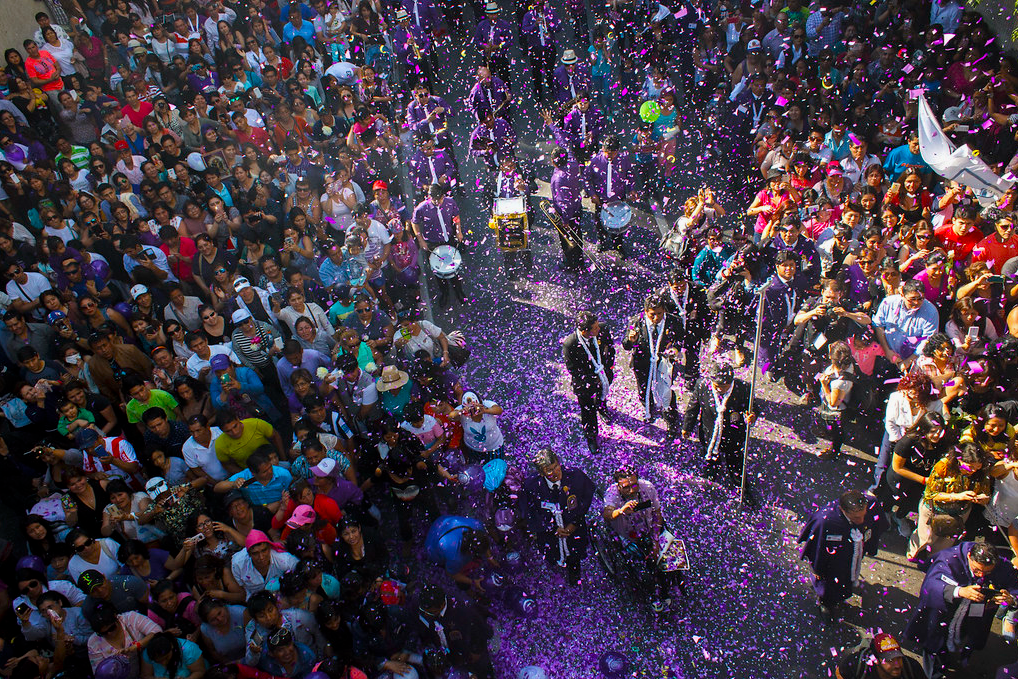
Wherever Peruvians are, you’ll find “Lord of the Earthquakes brotherhoods,” groups of faithful devotes who celebrate the festival outside Lima. These brotherhoods are also present in Peru’s biggest cities, such as Arequipa, Trujillo, Iquitos, Cusco, etc.
Additionally, you can discover them in areas with a concentration of Peruvian immigrants, such as Japan, the United States, Canada, Brazil, Spain, Italy, Argentina, etc.
The Procession
You can visit the original mural at El Santuario de las Nazarenas in downtown Lima. Each October, thousands of people gather there to celebrate the Purple Month. During this special time, many devoted followers wear purple robes to honor El Señor de los Milagros.
This happens on October’s first Saturday, as well as on October 18, 19, 28, and during the final procession on November 1. During this time, thousands of devoted followers join in to accompany the image. They pray, sing hymns, and express their hopes for miracles.
The procession is not only beautiful to see but also deeply moving. A dedicated group of men, known as “carriers,” carefully transport the heavy structure that holds the image through the streets of Lima. Meanwhile, thousands of onlookers, dressed in purple to show their devotion, come together to join this special occasion.
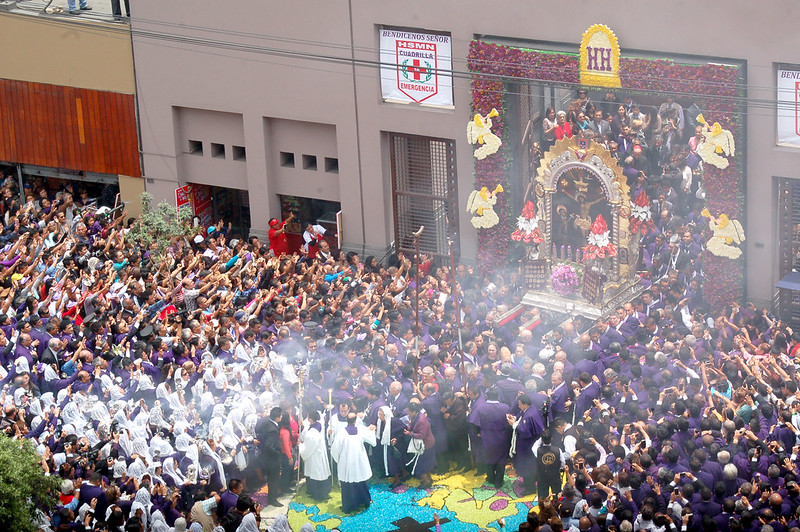
The Lord of Miracles festival showcases the main event: the grand procession that flows through the main streets of downtown Lima. Each October, the sacred image of the Lord of Miracles is brought out of the convent of Las Nazarenas several times.
Believers line the sidewalks, eager to witness the passing of the sacred image, praying with hope and gratitude. The atmosphere buzzes with energy as participants celebrate the miracles they have received and honor this cherished tradition.
This heartfelt display of faith is one of Peru’s most cherished events, attracting both believers and visitors from around the world. Over the years, the Lord of Miracles procession has grown into a key cultural and religious celebration, highlighting the deep dedication and rich traditions of the people.
The purple color
The color purple at the “El Señor de los Milagros” festival has a fascinating history, beginning with a wonderful woman named Antonia Lucía del Espíritu Santo. In the 17th century, she experienced many challenges in her life, yet messages from God filled her with strength and inspiration.
Antonia chose to wear the purple Nazarene habit as a symbol of her deep love and commitment. She believed that Jesus Christ had given her this robe since it was the one she was wearing. After becoming a widow in 1681, Antonia proudly opted to dress in purple and founded the Nazarene Institute in Lima.
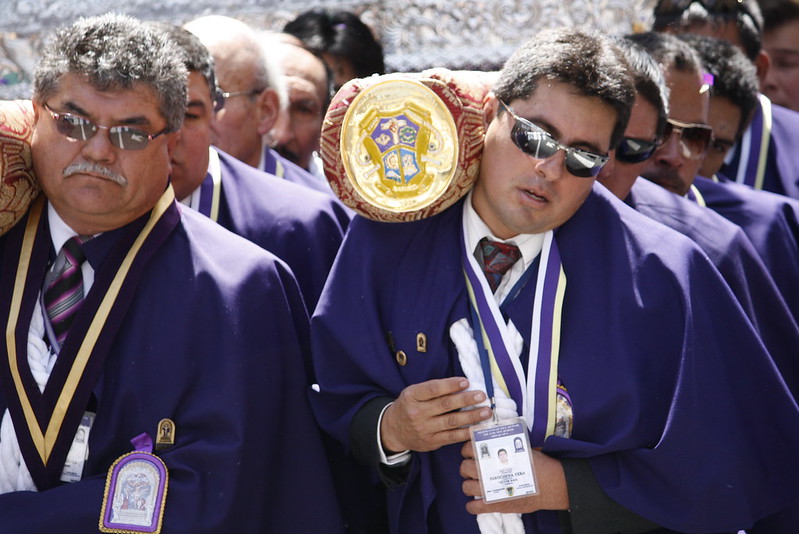
Her choice rapidly became a beloved emblem of faith among her followers. This noble ceremony subsequently became a key part of the Lord of Miracles parade. Over the years, purple has become the color that many wear during the “El Señor de los Milagros” celebrations, honoring both the figure of the dark-skinned Christ and Antonia’s inspiring legacy.
Today, the purple robes worn during the processions represent humility, faith, and a strong sense of tradition. They serve as a reminder of how Antonia Lucía’s spiritual journey has shaped this important Peruvian religious festival.
Purple Month Food
Turron de Doña Pepa
The Peruvian nougat consists of sticks made of flour and butter. Layers of this mix are piled up with “chancaca” , a sugar cane juice in a solid form mixed with Peruvian spices and honey. The top is adorned with colorful sprinkles and looks festive and delectable. Believe us when we tell you Peruvians love it. Although it’s common in october, you can find it all time of the year.
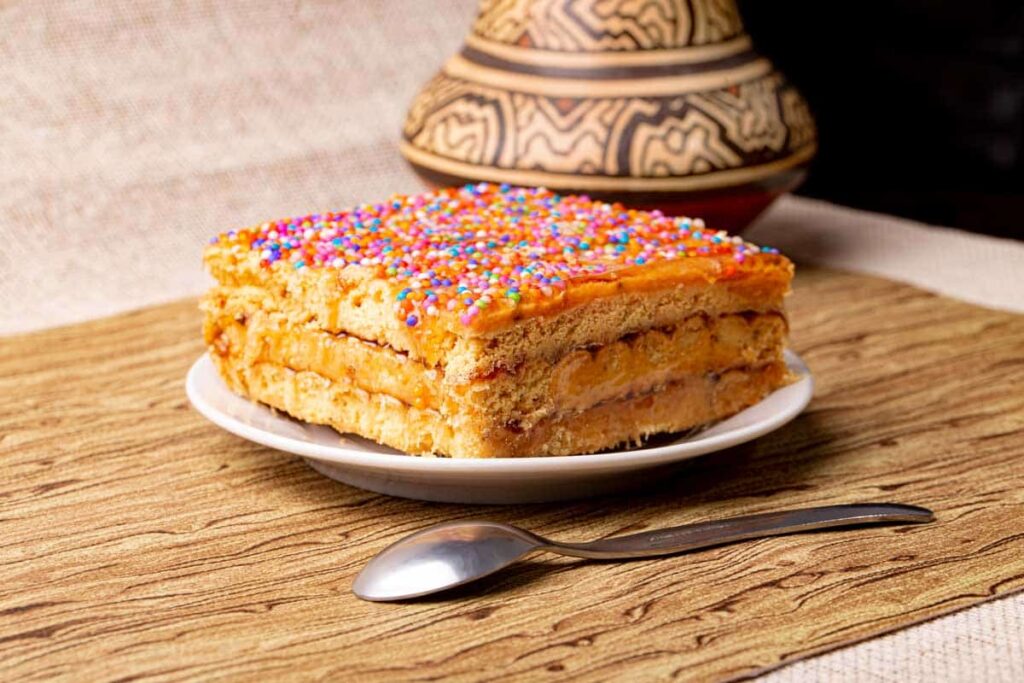
“El turron” also has a wonderful story, Josefa Martínez, an Afro-Peruvian woman, regained mobility in her arms after praying to El Señor de los Milagros. Inspired by a dream, she created a nougat recipe and shared it during the celebration. Whether you come to Peru in october or maybe another while you must try the delicious turron de doña Pepa!
Mazamorra Morada
“Mazamorra morada” is like a purple pudding made of boiling purple corn, mixed with pineapple skin, cloves, cinnamon, or other fruits. The result is an aromatic and distinctive purple-colored juice that is called “chicha morada”.
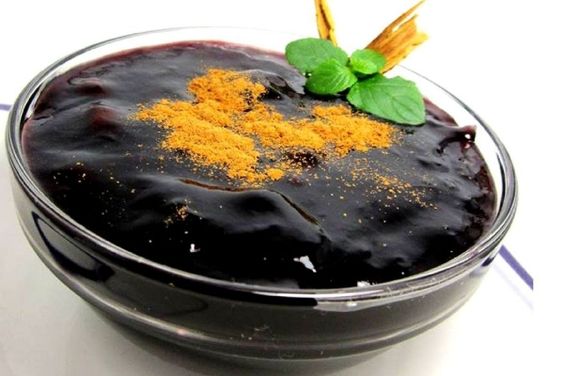
The difference between mazamorra is that you add cornstarch, sweeten it with chancaca, and sprinkle of grind cinnamon. The corn, in this case, the purple corn has a historical significance for Peruvians, and the smooth texture and sweet flavor of this dessert make it one of the favorites of Peruvians.
Picarones
Also known as “Peruvian donuts,” these treats are popular among both young and old people. Picarones are a Peruvian version of Spanish buñuelos, but more delicious, and flavorful. The dough is made from Peruvian pumpkin known as “zapallo”, or sweet potatoes.

They are deep-fried in a ring shape, resulting in a crispy outside and a soft inside. Picarones go well with a sweet sauce made from chancaca, Peruvian honey, and additional ingredients.
Anticuchos
As the “Lord of the Miracles” has African roots, in some spots in Lima you can find Peruvian food inspired by African cuisine, such as “anticuchos.” The story says that African slaves used to grill cow’s entrails in colonial Peru during the 16th century. This delicious and popular street food is practically everywhere: From fancy restaurants to modest street stalls.
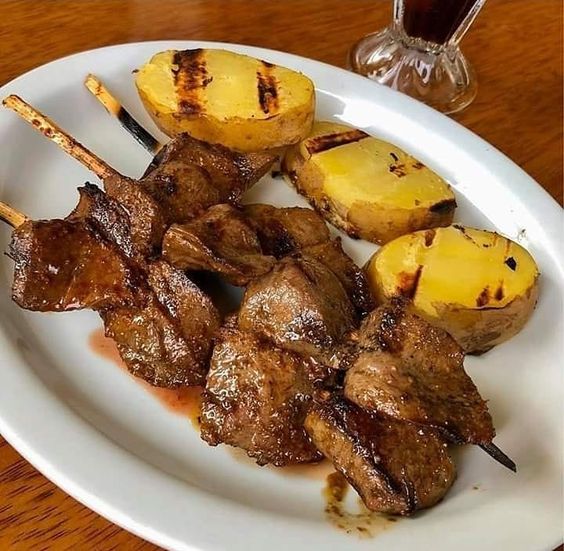
People make this Peruvian skewer from a cow’s heart. Yes, you read it correctly, but while the idea of eating an animal’s heart may not sound appealing at first, it is truly exquisite. The key to anticuchos is its flavor, and eating it with grilled potatoes and an assortment of Peruvian sauces makes it one of Peruvian people’s favorite street foods.
As you see, the lord of the miracles is more than faith and devotion, is a synonym for sharing, eating, and getting a closer look at the complex and fascinating culture in Peru. If you come this october, take a look at this massive celebration to learn more about our traditions.
In Lima or Peru, choose Viagens Machu Picchu for a better stay in our country. We operate all destinations in Peru and its most popular attractions. Contact our experts to start planning your trip to our country.
Viagens Machu Picchu, journeys that inspire, moments that last.

